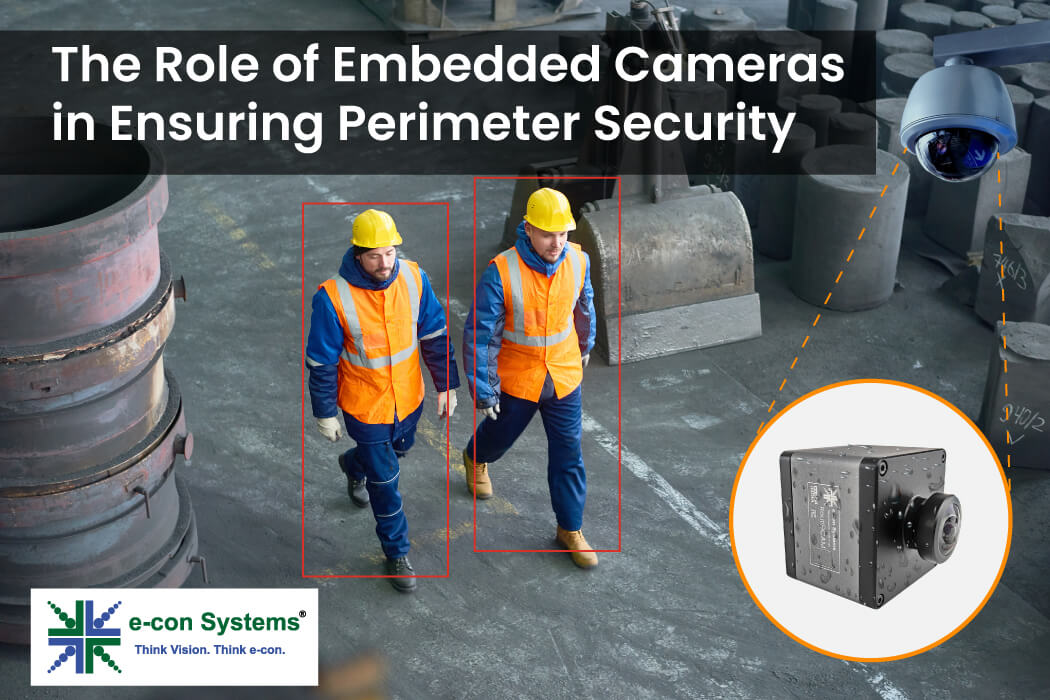Perimeter security defines the first layer of protection for many high-risk and high-value environments, from industrial plants and logistics hubs to power substations and data centers. Any breach along the perimeter poses an operational threat, triggering a cascade of issues that impact safety, property, and response timelines.
Traditionally, perimeter surveillance relied on a network of static CCTV units monitored from a centralized location. This approach comes with high bandwidth usage, increased operator load, and blind spots that limit coverage. The need to upgrade these setups has given rise to embedded camera systems. Unlike passive monitoring tools, embedded cameras operate as active endpoints that can detect, classify, and track.
In this blog, you’ll discover how embedded cameras work in perimeter security systems, their key features, and the top selection criteria.
How Embedded Cameras Are Used in Perimeter Security
Embedded cameras offer a combination of localized image capture and edge-side processing. A key advantage lies in response latency. Embedded cameras can detect events and anomalies without waiting for frames to travel to a central server for analysis. This is useful in scenarios like perimeter breach detection, where reaction time is directly linked to risk mitigation.
Embedded vision systems support modular installation along fences, gates, or infrastructure edges. The cameras operate in standalone mode or in clusters connected to edge gateways, with no dependence on high-bandwidth links or storage backends. This enables coverage of expansive zones while keeping infrastructure costs under control.
They are also adaptable to embedded AI frameworks. Many models are trained to recognize patterns, detect movement, and differentiate between human, animal, or vehicle activity. So, when cameras are paired with platforms such as NVIDIA Jetson, Ambarella or NXP i.MX8, they can process visual data in real time.
Key Camera Features for Perimeter Surveillance
Wide Field of View (FOV)
Surveillance across perimeter boundaries demands coverage over large distances. Cameras must capture distortion-free wide angles, enabling clear identification of motion across the scene. A broad horizontal FOV reduces the number of cameras needed per site and simplifies system design.
High resolution
Cameras must provide sufficient pixel density to detect intrusions at the edge of the visible range or recognize objects in motion. High-resolution imaging (4K or 8MP) delivers the granularity required to distinguish between moving shadows and actual threats.
When tied to neural inference systems, high-resolution frames improve classification accuracy. Features like clothing texture, object edges, or license plate details become usable at greater distances, improving output from detection algorithms.
High Dynamic Range (HDR)
Outdoor perimeter environments frequently experience lighting extremes like sunlight glare during the day, deep shadows at dusk, or mixed conditions near artificial lights. HDR imaging addresses these contrasts by combining multiple exposure levels in a single frame. It ensures that both bright and dark zones retain usable detail, helping surveillance systems operate around the clock while avoiding drop-offs in clarity.
Low light sensitivity
Surveillance does not stop when daylight ends. Nighttime monitoring depends on image sensors that retain visibility under low-lux conditions. Low-light sensitive cameras can operate under moonlight, dim LED backlighting, or even starlight, which makes them ideal for perimeters located in remote or power-constrained sites. Cameras equipped with IR filters or NIR sensitivity also improve visibility without revealing their position to intruders.
Rugged housing
Deployment at the perimeter exposes hardware to environmental wear. Cameras mounted on poles or fixed to structures face moisture, dust, and wide temperature ranges. Units built with IP-rated enclosures, sealed connectors, wipers to clear dust, and heat management features perform consistently despite external stresses. Such physical durability supports uninterrupted operation in field installations that remain unattended for long periods.
How to Choose the Right Embedded Camera for Perimeter Security
- Sensor and optics: A large-format sensor supports better low-light capture and enables a wider FOV when matched with suitable optics. The lens must be chosen based on the physical deployment range, desired coverage width, and object size at a distance.
- Onboard ISP: An integrated image signal processor reduces the need for external correction. It handles exposure adjustment, white balance, and de-noising on the device, providing clean output even under mixed lighting.
- Interface: Cameras used in perimeter systems often connect over MIPI or GigE interfaces. The interface type dictates bandwidth, cable length, and integration complexity.
- Platform support: Compatibility with embedded compute modules is another important parameter. Cameras that work seamlessly with platforms such as NVIDIA Jetson, NXP i.MX, Ambarella or Qualcomm QRB series can leverage built-in neural network engines, reducing the load on centralized systems.
- Thermal and power: Cameras deployed outdoors must operate across wide temperature bands. Thermal management through onboard sensors or active heating (e.g., lens defoggers) improves reliability. Power draw also matters. Basically, lower consumption supports deployment in solar-powered or battery-backed installations.
e-con Systems Offers High-Quality Cameras for Intelligent Surveillance
Since 2003, e-con Systems has been designing, developing, and manufacturing OEM cameras. We offer several camera modules that are perfect for surveillance applications that perform perimeter security tasks.
Browse our Camera Selector Page to check out our end-to-end portfolio.
If you need an expert to help find the right camera for your surveillance application, please write to camerasolutions@e-consystems.com.

Suresh Madhu is the product marketing manager with 16+ years of experience in embedded product design, technical architecture, SOM product design, camera solutions, and product development. He has played an integral part in helping many customers build their products by integrating the right vision technology into them.




